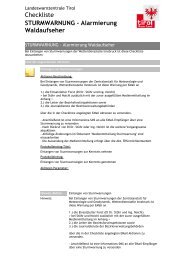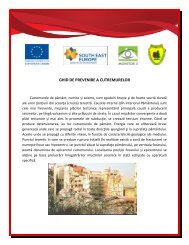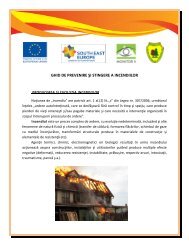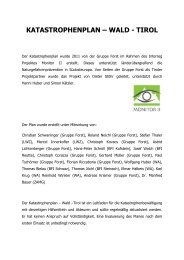risk management - monitor ii
risk management - monitor ii
risk management - monitor ii
You also want an ePaper? Increase the reach of your titles
YUMPU automatically turns print PDFs into web optimized ePapers that Google loves.
24 Monitor II Contingency plans<br />
Monitor II Contingency plans 25<br />
Contingency plans define necessary activities<br />
within disaster preparation phase.<br />
• Warning includes notifying and warning<br />
the population in the event of disasters.<br />
• Human resource <strong>management</strong> includes<br />
organising, equipping and training<br />
protection, rescue and relief forces as well<br />
as training the population for personal and<br />
collective protection.<br />
• Provision of materials resources<br />
includes provision of stocks of protective<br />
and rescue equipment as well as<br />
humanitarian aid equipment.<br />
Contingency plans for use in intervention<br />
phase define protection, rescue and relief<br />
measures in case of a particular disaster event.<br />
They are elaborated on the basis of the previous<br />
hazard assessment and <strong>risk</strong> assessment. They<br />
define the competent authorities and tasks to<br />
assure protection, rescue and relief.<br />
• Protection includes organisational,<br />
technical and other measures as well as<br />
the use of technical and other means for<br />
immediate personal and collective<br />
protection of people, animals, property,<br />
cultural heritage and environment against<br />
consequences of natural and other<br />
disasters.<br />
• Rescue includes measures and procedures<br />
for rescuing people the life or health of<br />
which is at <strong>risk</strong>, rescuing animals, property<br />
and cultural heritage from consequences of<br />
natural and other disasters.<br />
• Relief includes measures and services of<br />
specialists, rescue units and services, use of<br />
protection and rescue equipment and<br />
means of relief.<br />
They are enforced in response phase, starting<br />
with warning stage and including intervention<br />
measures. Their power ceases when standard<br />
operational procedures (SOP) of the intervention<br />
forces can take place and activities of<br />
recovery phase start.<br />
The development of contingency plans has to<br />
be based on clearly defined event scenarios,<br />
which are the outcome of hazard assessment.<br />
The effectivity of measures defined in contingency<br />
plans strongly depends on the quality<br />
of the scenarios considered (i.e. on the level of<br />
detail of scenario definition and how realistic<br />
they are defined).<br />
For contingency planning the scenarios<br />
considered are transformed into a series of<br />
action relevant situations. These situation<br />
definitions both include a description of the<br />
likely event (and: the parameters how it can<br />
be identified) and the intervention resources<br />
available, but also the social (legal) conditions<br />
of action.<br />
The measures defined in contingency plans<br />
relate to the situations of warning (prealert,<br />
alert and alarm) and disaster. For these<br />
situations contingency plans define<br />
• what are the characteristics of these<br />
situations (parameters like water gauge<br />
levels, number of available staff ressources)<br />
• how can these situations be identified,<br />
e.g. by means of <strong>monitor</strong>ing systems<br />
• how and to whom shall these situations<br />
be communicated<br />
• which measures shall be taken to counter<br />
the situation<br />
The contents of contingency plans<br />
usually include<br />
• general scope of the plan<br />
• description of the administrative structure<br />
and responsibilities<br />
• ressources and roles<br />
• hazards within the area concerned<br />
• elements at <strong>risk</strong> and vulnerability<br />
• scenario-specific situations and measures<br />
(usually repeated for each relevant scenario):<br />
· <strong>monitor</strong>ing<br />
· communication<br />
· protection, rescue and relief<br />
· evaluation and documentation<br />
Despite this high level of importance within<br />
disaster <strong>management</strong>, contingency planning<br />
still shows a surprisingly high heterogeneity<br />
when comparing different European countries.<br />
This heterogeneity can be shown by comparing<br />
the legal basis and the specific issue of<br />
<strong>monitor</strong>ing and warning.<br />
The legal and administrative<br />
framework<br />
The European Commission is responsible<br />
for supporting and supplementing efforts at<br />
national, regional and local level with regard<br />
to disaster prevention, the preparedness of<br />
those responsible for civil protection and the<br />
intervention in the event of disaster.<br />
The legislative framework for European<br />
civil protection enabled the Commission to<br />
establish a framework for effective and rapid<br />
co-operation between national civil protection<br />
services when mutual assistance is needed:<br />
• Civil protection financial instrument<br />
(adopted on 5 March 2007<br />
(2007/162/EC, Euratom)<br />
• Community civil protection mechanism<br />
(adopted on 8 November 2007<br />
(2007/779/EC, Euratom)<br />
The Community Civil Protection Mechanism<br />
and the Civil Protection Financial Instrument<br />
together cover three of the main aspects of<br />
the disaster <strong>management</strong> cycle – prevention,<br />
preparedness and response. The Mechanism<br />
itself covers response and some preparedness<br />
actions, whereas the Financial Instrument<br />
enables actions in all three fields. The two<br />
pieces of legislation are moreover complementary<br />
as the Financial Instrument finances the<br />
Mechanism.<br />
This European framework is integrated into<br />
national and regional legislation. The resulting<br />
competences are located at different<br />
administrative. This can be shown with the<br />
Austrian example.<br />
The implementation of the objectives of civil<br />
protection in Austria is effected mainly on the<br />
following two levels:<br />
Since May 2003 the Austrian Federal<br />
Ministry of the Interior (MOI) is responsible<br />
for the coordination in matters of disaster<br />
<strong>management</strong> on state level (SKKM), including<br />
international disasters and disasters involving<br />
more than one federal state. As a central<br />
contact point, the federal warning and alarm<br />
center (BWZ) and the emergency coordination<br />
center (EKC) were established at the Federal<br />
Ministry of the Interior (MOI). In case of<br />
prolonged and complex crisis and disaster<br />
situations the task of SKKM (National Crisis<br />
and Disaster Management) is to ensure the<br />
rapid coordination of the federal authorities<br />
and the coordination and cooperation with<br />
those countries.<br />
Disaster relief of the 9 Federal Provinces is<br />
responsible for measures to avert, remove<br />
or alleviate the effects of imminent or past<br />
disasters (disaster relief, action planning) on a<br />
regional level. The legal basis is provided by the<br />
catastrophe aid acts of the Federal Provinces,<br />
which are not harmonised and do show<br />
marked differences. They define particularly<br />
the establishment of the disaster and the<br />
operational responsibility by the authority on<br />
community, district and provincial level.<br />
Depending on the extent of a disaster the<br />
implementation of intervention measures rests<br />
with the authority level, as described in the<br />
figure below.<br />
Multi and bilateral treaty<br />
National Crisis and Emergency<br />
Management (SKKM)<br />
Civil Defense and Disaster<br />
Protection Management of the<br />
Federal States<br />
Disaster Protection<br />
Management of the Districts<br />
Disaster Protection Management<br />
of the Municipalities<br />
National<br />
Provinicial<br />
Regional<br />
Local<br />
Figure 24: Competence levels of disaster <strong>management</strong><br />
organisation in Austria<br />
Federal Ministry<br />
of the Interior<br />
Provincial<br />
Government<br />
District<br />
Administration<br />
Municipal<br />
administration








